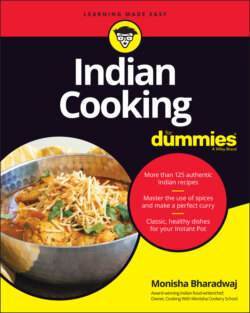Читать книгу Indian Cooking For Dummies - Monisha Bharadwaj - Страница 61
Spices
ОглавлениеYou need to need to get them right in order for your Indian cooking to work well. I’m always excited to see rows and rows of colorful spices at my local Indian shop. The aromas that hint of faraway lands are no less tantalizing. However, I’m aware of how overwhelming all this can seem to a novice. Spice names written in various Indian languages and scripts, as well as whole, crushed, and powdered forms of the same spice can be too much to handle. Plus, there are all those variations — for example, chile powder sold in various strengths of pungency, as well as from different regions of India.
Don’t worry, I won’t be going to ask you to go buy out your local Indian market. A few key spices and spice blends are all you need. After you’ve tested a few different brands and found the ones you love, you’ll be shopping like a pro!
When buying and storing spices and herbs, here are some useful tips.
Buy from a shop that does a brisk business. When lots of other shoppers go there to buy spices, shelves will be restocked more frequently and spices will be fresher. Typically, this means shopping at an Indian grocery store.
Buy small quantities. Often, buying in bulk is cost-effective, but in the case of spices, it isn’t. Ground spices last for around six months; the seeds last for a year. Even if a big bag is cheaper than several smaller ones, you may end up needing to throw it out. Better to buy two or three smaller bags and open one only after you’ve used up the previous one.
Store them in airtight containers in a dry, dark cupboard. Spices and herbs can deteriorate with light and air.
Use spices in other cuisines, too. That way, you’ll use them up faster and keep your stock fresh. Try adding a pinch of turmeric to rice and pasta, or add a bit of garam masala to your roast meat.
Depending on what your go-to recipes will be, buy a few key spices first and then build up your collection. The spices I can’t live without are:Black mustard seedsChile powderCumin seedsGaram masalaGround corianderGround cuminTurmeric
Table 4-1 can help you decide which spices to buy and suggests which dishes they compliment. When you become familiar with their flavors, you’ll feel confident to use them in other recipes too.
TABLE 4-1 Buying Spices
| Spice | Description |
|---|---|
| Ajowan | Also called ajwain, these small, sharp-tasting seeds give Indian fritters like onion bhajia and snacks their distinctive taste. |
| Amchur | Sometimes spelled amchoor, this is a dried green mango powder used to add a fruity sour note to samosa and stuffed bread fillings where moisture needs to be restricted. It’s also used in North Indian chutneys and salads. |
| Asafetida | This very strong-smelling powder comes from the root of a plant species of ferula. It’s used in small quantities for its digestive properties in recipes with lentils, beans, and certain vegetables. If you just can’t find it and a recipe calls for it, you can just leave it out. |
| Cardamom | Green cardamom is used in both savory and sweet recipes. It has a strong citrusy aroma. Black cardamom is bigger and has a smoky aroma. Look for plump pods when buying both. |
| Chaat masala | Chaat masala is a spicy, sour, salty blend of spices such as mango powder and chile. It’s sprinkled over snacks as a finishing spice. It’s sometimes sold as “chunky chaat masala.” |
| Chile powder | Varying heat levels are available, from mild to extra hot. I suggest a medium-hot variety, such as Kashmiri chile powder, which also gives dishes a lovely deep red color. |
| Cinnamon | The quills are crumbly, sweet, and aromatic. You can substitute cinnamon with cassia, which is cheaper, coarser, and slightly bitter but still aromatic. Both cinnamon and cassia are used in rice dishes and some curries. |
| Coriander | Coriander is available as seeds and ground — you’ll need both. Buy smaller packs of ground coriander because it loses its aroma quite quickly when opened. (Note: The leaves and stem of this plant are referred to as cilantro, but coriander is the term used for the dried seeds.) |
| Cumin | These small, long seeds are highly aromatic. You’ll need both the seeds and ground cumin. |
| Garam masala | Garam masala is an aromatic blend of spices such as cardamom, cinnamon, cloves, coriander, cumin, nutmeg, and pepper. Recipes vary so find a blend you like. |
| Fenugreek | Fenugreek is available as seeds and dried leaves, which are essential in dishes like butter chicken. The seeds are used in lentil and vegetable dishes. You can’t swap leaves with seeds, or vice versa, so pay attention to what the recipe calls for. |
| Mustard seeds | Mustard seeds are used a lot in South Indian cooking. Look for black or brown ones. Yellow mustard seeds are not commonly used. |
| Pepper | Pepper is used in spice blends and for seasoning. Buy black peppercorns and crush them at home in a peppermill for the freshest flavor. |
| Saffron | Saffron is the world’s most expensive spice. Look for Spanish or Kashmiri saffron. It’s used in small quantities in sweets and rice dishes. |
| Turmeric | This bright yellow-orange powder has an earthy aroma. Look for a vibrant hue. Fresh turmeric root is also available, but you can’t use it instead of the powder in Indian recipes. (I tried, so you don’t have to.) |
| Whole dried chilies | You’ll need chilies to add color and flavor to some curries such as rich lamb curries or South Indian dishes. Choose a dark red, mild variety such as Kashmiri chilies. |
